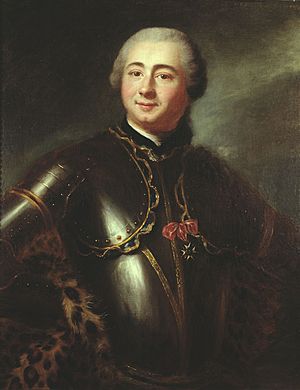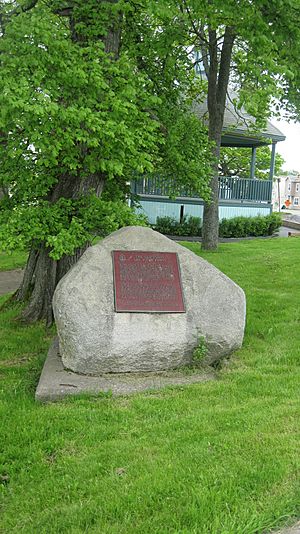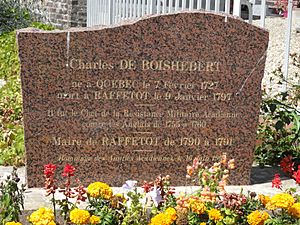Charles Deschamps de Boishébert et de Raffetot facts for kids
Quick facts for kids
Charles Deschamps de Boishébert et de Raffetot
|
|
|---|---|

Charles Deschamps de Boishébert
|
|
| Born | 7 February 1727 Quebec |
| Died | 9 January 1797 (aged 69) Raffetot, France |
| Allegiance | |
| Service/ |
French Army |
| Battles/wars | King George's War
|
Charles Deschamps de Boishébert (also known as Courrier du Bois) was an important French military leader. He was part of the Compagnies Franches de la Marine, a special unit of the French army. He played a big role in helping the Acadians resist the British during the Expulsion of the Acadians. Boishébert worked to protect Acadian refugees, helping them settle along the rivers in what is now New Brunswick. For example, he helped refugees at Beaubears Island during this difficult time.
Contents
King George's War
This war was a conflict between France and Britain in North America. Boishébert was involved in several key battles.
Siege of Annapolis Royal
From October to November 1746, Boishébert took part in a battle to capture Annapolis Royal, Nova Scotia. This was the main British base in Acadia. However, the French attempt was not successful.
Battle at Port-la-Joye
After the British captured Louisbourg in 1745, they also took over Île Saint-Jean (today's Prince Edward Island). Its capital was Port-la-Joye. In 1746, a French force was sent from Quebec to take back Acadia. Boishébert was sent to check on the British strength at Port-la-Joye. After his report, over 500 French and Mi'kmaq soldiers attacked. They defeated the British, killing 40 soldiers and capturing the rest.
Battle of Grand Pré
Boishébert also fought in the Battle of Grand Pré in 1747. French and Mi'kmaq forces attacked British soldiers stationed there. Boishébert was injured during this battle. After the French victory, he returned to Quebec.
Father Le Loutre's War
During Father Le Loutre's War, Boishébert worked to keep the Saint John River area under French control. He built Fort Boishebert and later rebuilt Fort Menagoueche at the river's mouth. He even disguised himself as a fisherman to check on the loyalty of the Acadians to France.
French and Indian War
This war was the North American part of the Seven Years' War. In 1754, Boishébert became the commander of Fort Menagoueche. He tried to stop the British from taking control of the Saint John River.
When the British won the Battle of Fort Beauséjour in 1755, it changed things for Boishébert. For the rest of the war, he led Mi'kmaq and Acadians in a guerrilla war against the British. This meant using surprise attacks and small groups of fighters. After Fort Beauséjour fell, Boishébert burned his own fort to prevent the British from capturing it. He then continued fighting from hiding among the local people.
Battle of Petitcodiac
Soon after the fall of Fort Beauséjour, Boishébert learned the British planned to attack Acadian villages. He arrived too late to save one village, but on September 3, 1755, he faced a British group at Petitcodiac. After a tough three-hour fight, the British fled, having lost many soldiers. Boishébert lost only one man. He returned to the Saint John River with many Acadian families who had escaped. In total, about 200 families avoided being deported.
He also ordered a surprise attack on Lunenburg, Nova Scotia in 1756. In January 1756, he sent men to burn a British ship, killing seven sailors. At the same time, Boishébert led 120 men against Fort Cumberland. In October 1756, he went to attack Fort Monckton, but the British had already left and burned it.
After the British captured Louisbourg in 1758, Boishébert moved many Acadians from the Port-Toulouse area to the safety of his post on the Miramichi River.
Acadian Refugee Camps

Boishébert set up refugee camps for Acadians fleeing deportation. These camps were located at Shediac, Miramichi, and on the Restigouche River. He spent time at the Shediac camp with 600 Acadians. The next year, he moved to Miramichi and created a camp called Le Camp d'Esperance (Cape Hope) at Beaubears Island. This camp housed between 1,000 and 3,500 Acadians. Conditions were very tough there.
He then set up another camp on the Restigouche River at Petit-Rochelle (today's Pointe-à-la-Croix, Quebec). After a battle in 1760, several hundred Acadians from this camp were captured. Boishébert worked hard to protect these settlements, but supplies were often scarce.
Ile Saint-Jean Campaign
He also helped Acadians leave Prince Edward Island during the Ile Saint-Jean campaign.
St. John River Campaign
Boishébert also helped Acadians during the St. John River campaign.
Siege of Thomaston, Maine
On August 13, 1758, Boishébert left Miramichi, New Brunswick with 400 soldiers to attack Fort St. George in Thomaston, Maine. They reached the fort on September 9 but were ambushed and had to retreat. This was Boishébert's last major Acadian mission. They then raided Friendship, Maine, where people were killed and taken prisoner.
Battle of Quebec
In the summer of 1759, Boishébert and Acadian volunteers helped defend Quebec. He also fought in the important Battle of the Plains of Abraham. In the winter, he returned to Acadia one last time to gather more soldiers and encourage the Acadians.
He was defeated by Captain John Byron in the Battle of Restigouche. This battle was the final blow for New France. After this, Boishébert returned to France. He was later questioned about financial matters related to the colony. After 15 months, he was cleared of any wrongdoing.
In 1763, Boishébert was involved in plans to settle Acadians in Cayenne (now French Guiana). He also tried to get a military job there but was unsuccessful. In 1774, his request to be an inspector of colonial troops was turned down. He sold his Canadian land, called Rivière-Ouelle, that same year. He lived in France at Raffetot, a property he gained through his marriage, until his death on January 9, 1797. He was even the mayor of Raffetot from 1790 to 1791.



